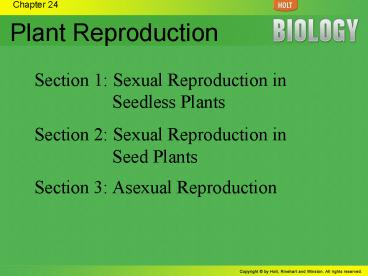Plant Reproduction - PowerPoint PPT Presentation
1 / 12
Title:
Plant Reproduction
Description:
Life Cycle of a Moss In mosses, the 'leafy' green gametophytes are larger than ... The thin, green, heart-shaped gametophytes produce both sperm and eggs. ... – PowerPoint PPT presentation
Number of Views:30
Avg rating:3.0/5.0
Title: Plant Reproduction
1
Chapter 24
Plant Reproduction
Section 1 Sexual Reproduction in Seedless
Plants
Section 2 Sexual Reproduction in Seed Plants
Section 3 Asexual Reproduction
2
Section 1
Sexual Reproduction in Seedless Plants
Objectives
- Summarize the life cycle of a moss.
- Summarize the life cycle of a fern.
- Compare and contrast the life cycle of a moss
with the life cycle of a fern.
3
Section 1
Sexual Reproduction in Seedless Plants
Reproduction in Nonvascular Plants
- Life Cycle of a Moss In mosses, the leafy green
gametophytes are larger than the sporophytes,
which consist of a bare stalk and a spore
capsule. Water is necessary for fertilization.
4
Section 1
Sexual Reproduction in Seedless Plants
Reproduction in Seedless Vascular Plants
- Life Cycle of a Fern In the life cycle of a fern,
the sporophytes are much larger than the
gametophytes. The thin, green, heart-shaped
gametophytes produce both sperm and eggs. Water
is necessary for fertilization.
5
Section 2
Sexual Reproduction in Seed Plants
Objectives
- Distinguish the male and female gametophytes of
seed plants. - Describe the function of each part of a seed.
- Summarize the life cycle of a conifer.
- Relate the parts of a flower to their functions.
- Summarize the life cycle of an angiosperm.
6
Section 2
Sexual Reproduction in Seed Plants
Reproductive Structures of Seed Plants
- Reproductive Structures The tiny gametophytes of
seed plants develop from spores that remain
within sporophyte tissues. Male gametophytes
develop into pollen grains, while female
gametophytes develop inside ovules.
7
Section 2
Sexual Reproduction in Seed Plants
Seeds
- Parts of a Seed A seed contains an embryo, which
is a new sporophyte, and a supply of nutrients
for the embryo. The cotyledons of an embryo help
transfer nutrients to the embryo. A seed coat
covers and protects a seed.
8
Section 2
Sexual Reproduction in Seed Plants
Cones
- Life Cycle of a Conifer In gymnosperms, male and
female gametophytes develop in separate cones on
the sporophytes. After fertilization, ovules
develop into seeds, which grow into new
sporophytes.
9
Section 2
Sexual Reproduction in Seed Plants
Flowers
- Flowers and Their Pollinators Flowers have four
types of partspetals, sepals, stamens, and
pistils. Petals attract pollinators. Sepals
protect buds and may also attract pollinators.
Pollen forms in anthers of stamens. Seeds develop
in the ovary of a pistil. - Life Cycle of an Angiosperm In angiosperms, male
and female gametophytes develop in the flowers of
the sporophytes. After fertilization, ovules
develop into seeds, which grow into new
sporophytes.
10
Section 3
Asexual Reproduction
Objectives
- Describe several types of vegetative reproduction
in plants. - Distinguish sexual reproduction in kalanchöes
from asexual reproduction in kalanchöes. - Recommend several ways to propagate plants.
11
Section 3
Asexual Reproduction
Vegetative Reproduction
- Vegetative Reproduction Vegetative reproduction
is the growth of new plants from nonreproductive
plant parts, such as stems, roots, and leaves.
12
Section 3
Asexual Reproduction
Plant Propagation
- Vegetative Reproduction People often grow plants
from their vegetative structures. This is called
vegetative propagation.































